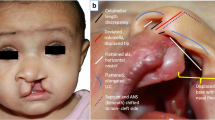Abstract
Background
Nose cleft is a rare congenital malformation. According to the Tessier classification, it can appear as a part of craniofacial cleft numbers 0, 1, 2, or 3. However, it can also be observed as an isolated nose cleft. The aim of this study was to present our experience in the treatment of isolated cleft nasal deformity.
Methods
A retrospective study of all patients with isolated nose cleft treated at our clinic between years 1995 and 2015 was undertaken. The collected data included age, sex, type of cleft, coexisting malformations, and methods of treatment.
Results
Over a period of 20 years, 28 patients with isolated cleft nasal deformity (11 males and 17 females)were treated. In the examined group, there were 21 patients with median nose cleft and seven with cleft of the ala nasi. Patients from the median nose cleft group were operated on in two or three stages. In the first stage, a procedure involving soft tissue and nose cartilage was performed, while in the second phase, rhinoplasty with osteotomy was performed. One patient had his treatment accomplished in three stages. Patients from the ala nasi cleft group underwent procedures performed with methods of local plasty or flap rotation.
Conclusions
Nose clefts are characterized by a variable clinical picture (midline cleft vs ala nasi cleft and total cleft vs partial cleft). The nose cleft is not always a part of craniofacial clefts as isolated forms of such malformations can also occur. This type of congenital anomaly requires always an individual treatment plan.
Level of Evidence: Level IV, therapeutic study.




Similar content being viewed by others
References
Guruprasad Y, Chauhan DS (2014) Midline nasal dermoid cyst with Tessier’s 0 cleft. J Nat Sci Biol Med 5:479–482
Bradley JP, Kawamoto H (2007) Craniofacial clefts and hypertelorbitism. In: Grabb and Smith’s plastic surgery, 6th edn. Lippincott & Williams & Wilkins, Philadelphia, USA, pp 268–80
Ortube MC, Dipple K, Setoguchi Y, Kawamoto HK Jr, Demer JL (2010) Ocular manifestations of oblique facial clefts. J Craniofac Surg 21:1630–1631
Allam KA, Wan DC, Kawamoto HK, Bradley JP, Sedano HO, Saied S (2011) The spectrum of median craniofacial dysplasia. Plast Reconstr Surg 127:812–821
Jinka JR, Chekuri H, Annavarapu G (2012) Isolated cleft of the ala nasi: a report of seven cases. Indian J Plast Surg 45(3):512–515
Reddy SG, Reddy RR, Obwegeser J, Mommaerts MY (2014) Options for the nasal repair of non-syndromic unilateral Tessier no. 2 and 3 facial clefts. Indian J Plast Surg 47:340–345
Newman MH, Burdi AR (1981) Congenital alar field defects: clinical and embryological observations. Cleft Palate J 18:188–192
Núñez-Villaveirán T, Frohner BB, Urcelay PR, Sánchez RL, Molina CM, Palacios ET (2013) Bifid nose—a mild degree of frontonasal dysplasia. A case report. Int J Pediatr Otorhinolaryngol 77:1374–1377
Turkaslan T, Ozcan H, Genc B, Ozsoy Z (2005) Combined intraoral and nasal approach to Tessier No: 0 cleft with bifid nose. Ann Plast Surg 54:207–210
da Silva FR, Alonso N, Shin JH, Busato L, Ono MC, Cruz GA (2008) Surgical correction of Tessier number 0 cleft. J Craniofac Surg 19:1348–1352
Miller PJ, Grinberg D, Wang TD (1999) Midline cleft. Treatment of the bifid nose. Arch Facial Plast Surg 1:200–203
Ortiz Monasterio F, Fuente del Campo A, Dimopulos A (1987) Nasal clefts. Ann Plast Surg 18:377–397
Fijałkowska M, Antoszewski B (2015) Rare facial clefts. Pol Przegl Chir 87:389–394
Author information
Authors and Affiliations
Corresponding author
Ethics declarations
Conflict of interest
Marta Fijałkowska and Bogusław Antoszewski declare that they have no conflict of interest.
Informed consent
Parents or legal guardians provided written consent before the inclusion of patients in this study. Additional consent was obtained for the use of patients’ images.
Ethical standards
All procedures performed in studies involving human participants were in accordance with the ethical standards of the institutional and/or national research committee and with the 1964 Helsinki Declaration and its later amendments or comparable ethical standards. For this kind of retrospective study formal consent is not required.
Funding
None
Rights and permissions
About this article
Cite this article
Fijałkowska, M., Antoszewski, B. Nose clefts: own experience of treatment with different types of congenital nasal anomalies. Eur J Plast Surg 39, 409–414 (2016). https://doi.org/10.1007/s00238-016-1220-8
Received:
Accepted:
Published:
Issue Date:
DOI: https://doi.org/10.1007/s00238-016-1220-8




